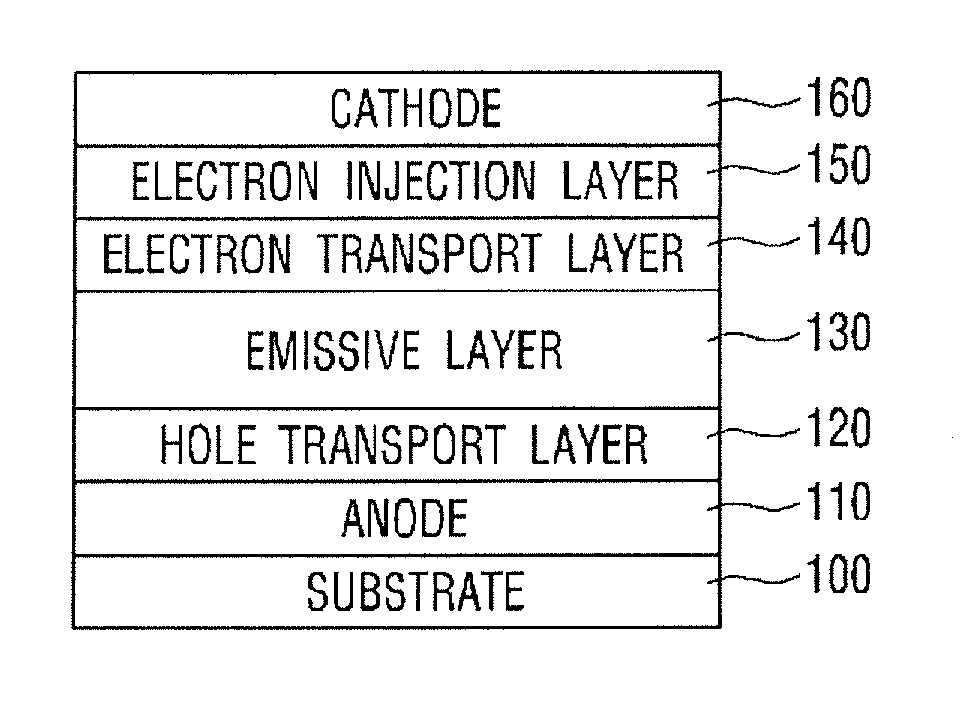Organic light-emitting diodes
a light-emitting diode and organic technology, applied in the field of multi-layered organic light-emitting diodes, can solve the problems of reducing the life span of the element, obtaining a sufficient coating performance, and materials that are not easy to handle during processing, so as to improve the light-emitting efficiency of the light-emitting diode, and improve the light-emitting efficiency
- Summary
- Abstract
- Description
- Claims
- Application Information
AI Technical Summary
Benefits of technology
Problems solved by technology
Method used
Image
Examples
embodiment 1
[0064]Further, the electron injection layer 150 may be formed by using a metal ion. The metal ion forms the ZnO nanoparticle of the electron transport layer and compounds such as ZnO:Cs, ZnO:Li, ZnO:Mg, ZnO:Al, ZnO:Ca, ZnO:Na and ZnO:Ba. According to the method for forming the electron injection layer 150 by using the metal ion, LiF, CsF, NaF, Cs2CO3, Ca(acac)2 and the like of the salt of the liquefiable alkali metal and liquefiable alkaline earth metal are dissolved in a polar solvent, and then this solution is used to form the electron injection layer 150. According to a method using a depositing metallic material as the electron injection layer, the alkali metal and alkaline earth metal such as Ca, Na, Mg, Li, Ba and Cs and the like and LiF, CsF, NaF, Cs2CO3, Ca(acac)2 of a salt form are deposited. An example that the electron injection layer 150 of the first organic light-emitting diodes is formed by using the metal ion as mentioned above will be described in the following
[0065]...
embodiment 2
[0072]With respect to the electron injection layer 150, the electron injection effect can be increased not only by adding an organic polymer material and organic low molecular weight material which include ammonium salts or an organic polymer material and organic low molecular weight material which include amino group, but also by using the surfactant and organic salts of ammonium series. This corresponds to the following description of
[0073]The electron injection layer 150 is formed by using an ionic polymer material including an ionic group, and is also formed by using an n-type polymer material or an n-type low molecular weight material. An example that the electron injection layer 150 of the first organic light-emitting diodes is formed by using the ionic polymer material including an ionic group will be described in the following embodiment 2.
[0074][Embodiment 2]
[0075]Anode: manufactured with indium tin oxide (ITO) glass, deionized water, acetone and isopropyl alcohol (IPA) are...
embodiment 4
[0090]An example of forming the electron injection layer 220 of the second organic light-emitting diodes by using metal ion will be described in the following
PUM
 Login to View More
Login to View More Abstract
Description
Claims
Application Information
 Login to View More
Login to View More - R&D
- Intellectual Property
- Life Sciences
- Materials
- Tech Scout
- Unparalleled Data Quality
- Higher Quality Content
- 60% Fewer Hallucinations
Browse by: Latest US Patents, China's latest patents, Technical Efficacy Thesaurus, Application Domain, Technology Topic, Popular Technical Reports.
© 2025 PatSnap. All rights reserved.Legal|Privacy policy|Modern Slavery Act Transparency Statement|Sitemap|About US| Contact US: help@patsnap.com



